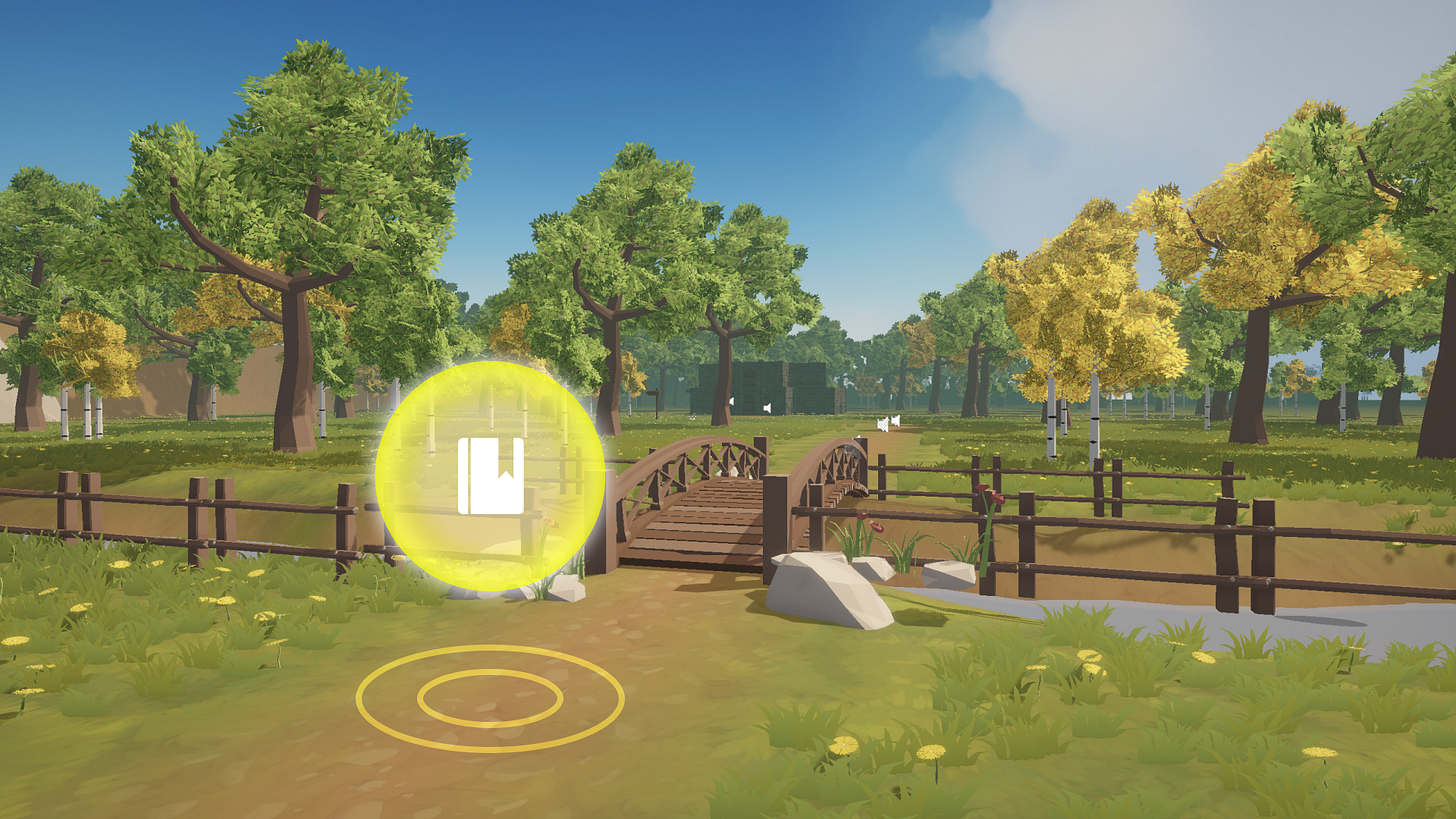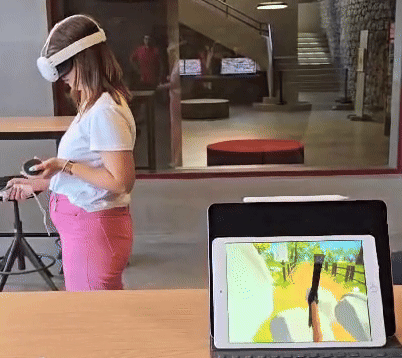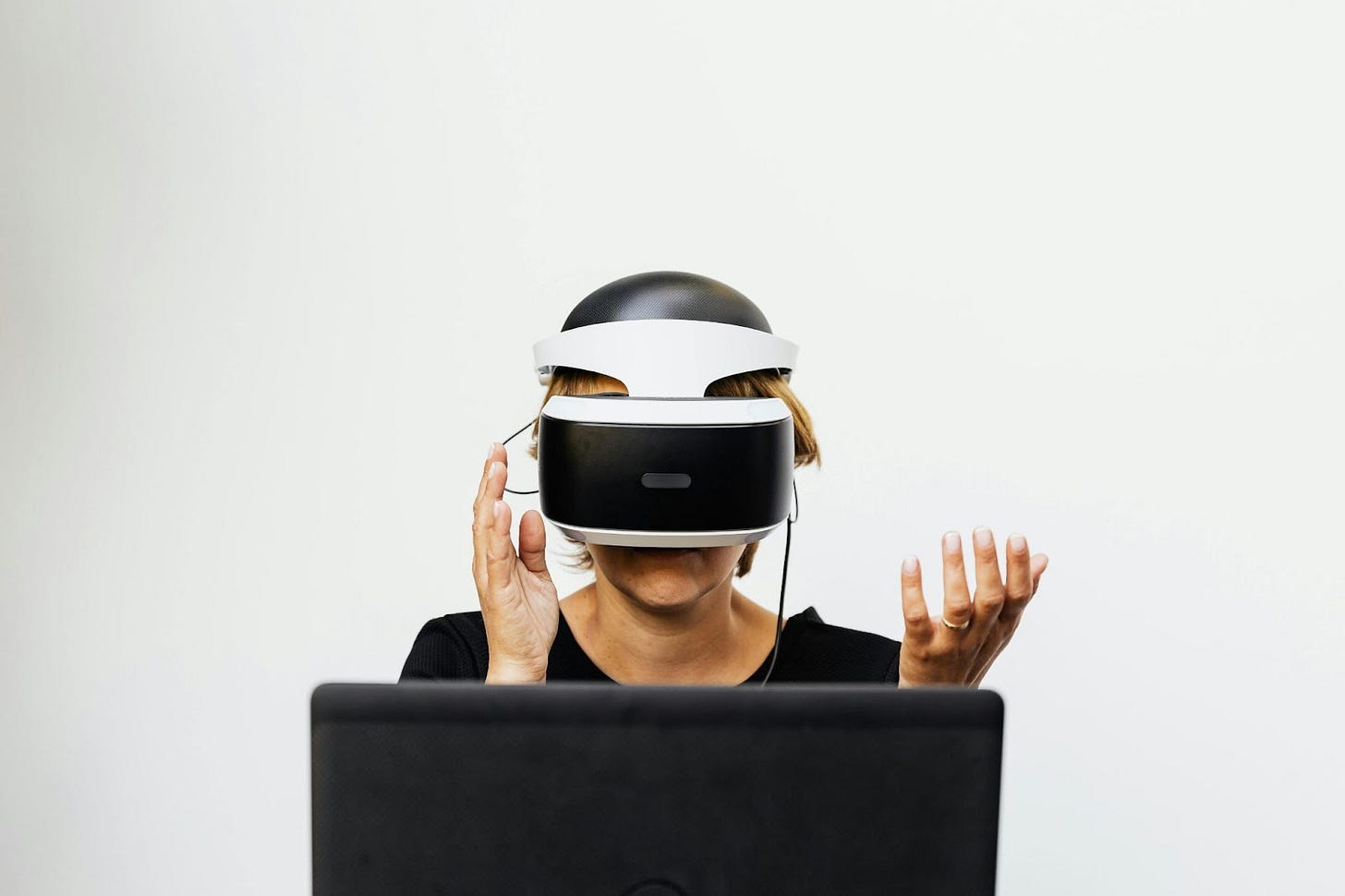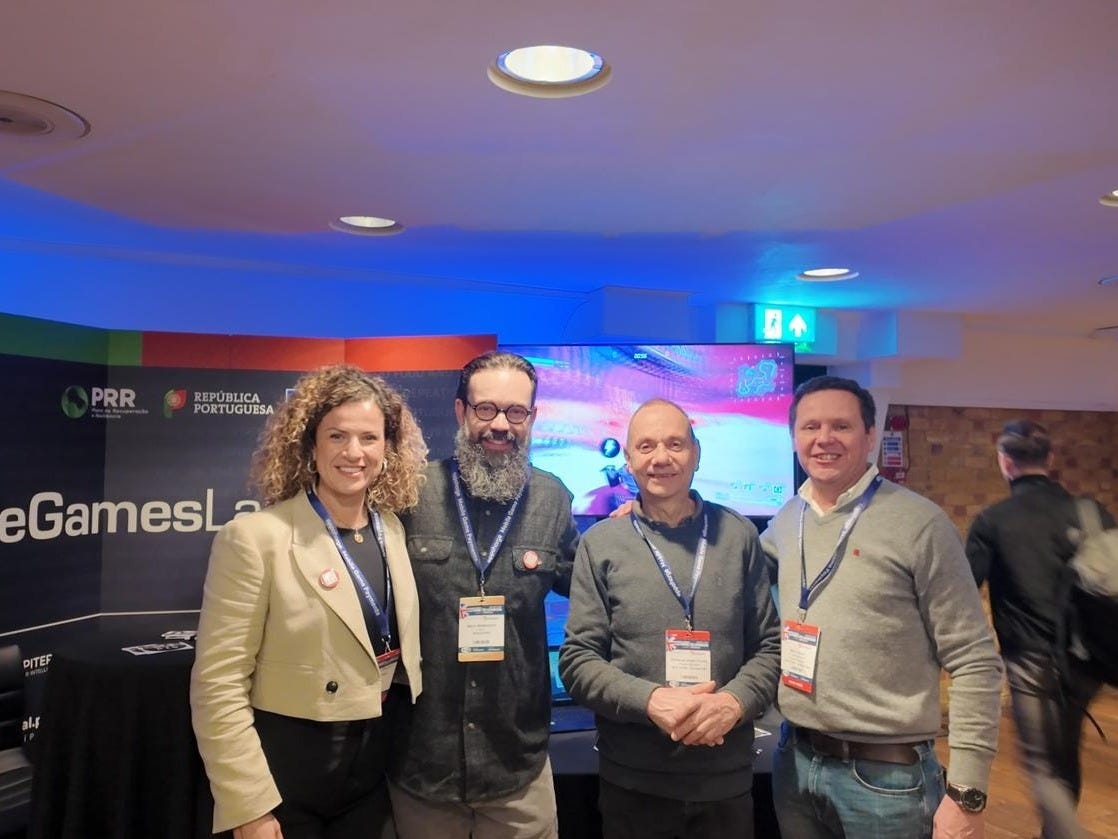WalkMe Mobile Solutions Reveals Its First VR Project After a Decade in Mobile Game Development
Plus, Portuguese game developers share their thoughts on what’s to come in 2025
Welcome back to Games From Portugal, your monthly update on Portugal's thriving video game development sector. As always, this newsletter is brought to you by eGames Lab, Portugal’s unique e-games development and creative industries cluster.
This month, the focus is on immersive technologies. First, we check in with WalkMe Mobile Solutions to learn about Trivia World Quest, the Portuguese mobile game studio’s first-ever project in virtual reality. After that, we discuss some of the nuances between VR and AR with FootAR CEO and founder David Olim. Finally, three Portuguese game developers tell us what to expect from the games industry in 2025.
Trivia World Quest: WalkMe Mobile Solutions on Its Transition Into VR After a Decade in Mobile Games
There comes a time in the life of every game development studio when they decide that it’s time to take on a new challenge. For WalkMe Mobile Solutions – a Portuguese game studio that has generated more than 40 million downloads worldwide from its extensive portfolio of pocket-sized puzzlers over the past decade – that moment of change came as the team were walking around last year’s GDC and trying out innovative projects from game developers all over the world.
“We had this crazy idea: what if we take all the experience we’ve built over the past ten years on mobile and use it to create something in VR,” says Lígia Gonçalves, the studio’s CEO and founder. “It meant leaving our comfort zone in terms of platform, but it didn’t change what we know about building puzzle games. We know what players like and what’s important to them.”
Once Gonçalves and the rest of the team were back in the office in Madeira, they began to put on their thinking caps, and it wasn’t too long before Trivia World Quest was born. The latest instalment in one of WalkMe’s most popular mobile puzzle game franchises, Trivia World – where players progress through a fantasy world by answering general knowledge questions – Quest massively expands the pocket-sized experience into an entire virtual world that challenges the player in three core areas across fully-explorable levels.
The first of those core areas is the mind. As players progress through each level, they encounter enigmas they must overcome using their wits. Second is where the VR elements become the most prevalent: the body. Players need to physically move to overcome obstacles, such as using a pickaxe to break a wall or reaching out toward ledges to ascend a mountain.
Third and finally is knowledge. Quest is loaded with thousands of questions players have to answer. In a nice touch, the questions players are presented with are personalised to their region and language, too. For example, those based in the US might get questions about landmarks in Washington D.C., while those in the developer’s home country of Portugal would get similar questions about Lisbon.
“Everything has been designed to create something truly immersive for players,” says Gonçalves. “You're not just answering questions – it’s an active, seamless experience where players can engage with their surroundings while expanding their knowledge.”
The game, which Gonçalves hopes to launch later this year, has been progressing well so far. The first level will debut to the public at GDC in San Francisco in just a month. However, as one might expect, shifting from a mobile game studio to a VR-focused one after ten years in the industry has been challenging.
WalkMe Mobile suddenly went from natively building 2D trivia games for mobile to learning how to design fully 3D environments in Unity. It wasn’t an easy transition, and it required bringing an additional team member on board with the knowledge to bring the studio into an all-new dimension.
“Developing for VR is a completely different experience to designing other games,” says Gonçalves. “It’s not just about interacting with a screen anymore; players aren’t tapping with their fingers but using their hands in a fully immersive environment. This brings unique challenges, one of the biggest being motion sickness. If movement in the game is too fast or unnatural, players will just remove the headset and stop playing.”
Another challenge the team is still getting to grips with is profitability. As anyone who has played a mobile game will know, most games on that platform – WalkMe Mobile’s titles included – are free-to-play and generate revenue through ad monetisation and in-app purchases. While Trivia World Quest’s pricing model is yet to be finalised, it will likely follow a structure that’s more in line with other VR titles, which are primarily premium games.
However, WalkMe has also learned plenty of lessons from past projects that have been put to good use in this latest endeavour. For example, while Trivia World Quest will be a primarily single-player experience (although Gonçalves says this could change with future updates post-launch), it will incorporate some light multiplayer components, such as online rankings and leaderboards, which are commonplace on mobile.
Speaking of content coming further down the line, Gonçalves says that the studio has also been exploring incorporating generative AI into the game alongside other members of the eGames Lab consortium. While this feature won’t be readily available for the title’s debut at GDC next month, it will allow players to engage in full-blown conversations with NPCs throughout the game world when it launches later this year. We’ll be first in line to try it out once it’s ready.
Understanding Immersive Tech: What’s Next for VR and AR?
It’s taken a long time for virtual reality to finally live up to its promise of transforming how we can interact with digital content, so much so that you’d be forgiven for forgetting how long it's been. Developers have been experimenting with virtual reality for around half a century, particularly in video games, with Mattel and Nintendo trying their hand with the Power Glove and Virtual Boy in the 1990s.
While the problems with such early iterations of VR technology have been well-documented, we’ve come a long way since then. Advancements in technology have made the achievements of headsets like the Meta Quest 3 and Valve Index a reality in consumers' homes all over the globe, even if the high entry fee remains a barrier for many. However, VR isn’t the only immersive technology that’s experienced significant growth over the last few years; augmented reality also has an increasing presence.
AR is arguably only just finding its footing compared to virtual reality, although significant investment has already been made, with Meta alone investing upwards of $100 billion in the technology. While AR and VR share many similarities, they also have unique nuances. David Olim, CEO of FootAR, knows about those differences better than most. Below, he shares his thoughts and discusses where these technologies are heading.
The Differences Between VR and AR
If you see two people using a VR and AR headset side-by-side, the devices may look similar, but their experiences are fundamentally different. While some headsets, like Meta Quest 3 and Apple Vision Pro, support both technologies, most are optimised for either AR or VR. At the most basic level, VR transports users to a fully digital environment entirely closed off from the real world, while AR blends things together by overlaying digital elements onto the real world.
While that might sound like a minor distinction, it has resulted in significantly different use cases and adoption paths for each technology. VR, for example, naturally aligns with video games, allowing players to get even more immersed as they explore. While AR still has a place in gaming, such as within titles like Pokemon GO, its combination of digital and real-world elements makes it suitable for various applications in different industries.
For example, FootAR uses the technology to enhance the experience of viewing live sports by overlaying real-time data (such as player statistics and game analytics) onto a digital recreation of the football pitch. AR is also used in healthcare settings, such as to assist surgeons, and in education, including teaching users how to play musical instruments by guiding them toward the right notes.
“VR has been widely adopted in gaming, which has shaped public perception, but it is also gaining traction in industries such as healthcare, enterprise collaboration, and industrial training. AR is seen as more suited to professionals, although it also has plenty of use cases in our everyday lives,” says Olim. “Those perspectives stem from how developers are using the technology, but we see the situation as more of a blend of technologies with shared use cases. AR has lots of potential in games; likewise, VR can be helpful in a professional setting too.”
Building for AR vs VR
The differences between VR and AR go beyond how they are experienced; they also extend to how content is developed for each technology. Olim notes that VR developers must work around physical space limits by using movement techniques like teleportation, smooth locomotion and redirected walking to keep the experience immersive. With AR, that’s less of an issue, as users can still see what’s around them.
“Thanks to evolutions in hardware, AR can now recognise elements like tables, floors, and chairs, enabling us to create personalised content that responds to the user’s actual surroundings in real time,” says Olim. “We can use the environment as the playground, which makes the whole experience feel dynamic.”
Whether a developer opts for VR or AR, one thing that must be kept in mind is the install base. While they’ve become more mainstream, the generally high entry fee for headsets means they’re still somewhat of a niche. Those opting to develop software for these platforms will typically have a much lower potential audience than a more traditional mobile application. That being said, 9.6 million VR headsets were sold last year worldwide, so there is plenty of appetite for this technology.
Where Is AR and VR Technology Heading in the Future?
Olim firmly believes that the lines between AR and VR will only become blurred. This is already happening, with the Apple Vision Pro and Meta Quest devices boasting a combination of both technologies – although the former’s exceptionally high $3,500 price tag puts it out of the reach of many. The Meta Quest, Pico and HTC Vive are more affordable alternatives, offering mixed reality capabilities at a fraction of the cost, making immersive experiences accessible to a broader audience.
“VR and AR don’t need to be separated,” says Olim. “The hardware is capable of doing both, and it’s much better for the user if they only have to purchase one thing that can offer the best of both worlds. As extended reality becomes more popular, it will be the key differentiator in transforming this from a trend into an integrated part of everyday life.”
What’s to Come In 2025? Views From the eGames Lab Consortium
After everything that happened in the games industry in 2024, there’s a lot to consider about the year ahead. From the growing number of layoffs and shutdown of various major live service projects to the rise of AI-based technologies, it’s hard to say how things might look when 2026 finally comes around in 11 months' time. We asked experts from three Portuguese game developers for their thoughts on what to expect.
Marco Bettencourt, CEO and Founder of Redcatpig
What do you predict will be the biggest shake-up in 2025?
“The biggest shake-up will be in how AI technology shakes up the whole game development scene. I can see a lot of value in it, but I can also see that people are almost desperate to find a way to get AI into their games, and I think that’s where things are going all wrong. There’s always new technology and buzzwords, but forcing something into production isn’t the right approach. If there’s a need for it and it makes sense, then sure, but injecting it into projects like a tool to save cash is a recipe for a disaster.
“At Redcatpig specifically, we've been using it at a management level, and it makes a lot of sense there. Our artists have also been doing some tests, but we still don't have a good enough outcome to say we will use AI in our workflow. There’s just not enough proof that it will give us any value.”
What key takeaway from 2024 are you bringing into 2025?
“Considering what Redcatpig does, which is working on our own IPs alongside external projects, we’ll definitely take more things in-house. I've seen the value of creating our own teams for every project needed to make a game, like for music production, VFX and others.
“But to balance that, we’re learning how to manage the human side of things. We’ve seen so many shutdowns and layoffs and been contacted by so many people looking for work. We’re trying to get into a position where we can bring more people in. Of course, we can scale and give these people a new home, but at the same time, we want to keep the same indie mentality.
“People are sick and tired of corporate mentality. I’m not saying we don’t need to make money because we obviously do. When I say we want to avoid corporate mentality, I’m not talking about the part that’s being organised, responsible, and ensuring everyone gets their paycheck. It’s more about taking care of people and seeing them as more than a number.”
André Miraldo, Marketing Lead at Infinity Games
What do you predict will be the biggest industry shake-up in 2025?
“I can picture two things happening. As everything is a cycle, the return of ad-focused games for mobile since there has been an overwhelming amount of IAP-focused games, many of which focus on gambling mechanics. Consumers may return to more streamlined mechanics, not paying to win even if they have to watch an ad or three.
“The other prediction is a return to a consumer-first policy, making games focused on the consumer and not only profit-driven. This year, we saw more GAAS shut down and many ambitious projects cancelled as studios figure out that investment does not mean the game will sell well or please the genre's player base. With this in mind, I believe the fun in games may gradually come back, and innovation in gameplay is sure to bloom.”
What key takeaway from 2024 are you bringing into 2025?
“Trust in the team, the process and the market. Do not rush projects based on the first competitor or game of said genre; instead, try to ideate on what makes that game stand out and why people still prefer a variant over another. Good market research is a great segway into good design, which will flesh out the feel of the product you are trying to deliver and improve.”
Lígia Gonçalves, CEO and Founder of WalkMe Mobile Solutions
What do you predict will be the biggest shake-up in 2025?
“I believe the biggest revolution in 2025 will be even deeper integration of artificial intelligence into all aspects of our lives, from the simplest to the most complex tasks. AI is becoming increasingly present in our daily lives, automating processes, speeding up decision-making, and optimising resources. This technology saves us time and allows us to focus on activities that require more creativity and critical thinking. In video games, AI is transforming the way we play with more intelligent characters, more dynamic narratives, and more personalised experiences.
“On the other hand, virtual reality will also be a very present reality in our daily lives, bringing incredible experiences to various sectors, opening doors to new forms of interaction and unique experiences. Imagine, for example, being able to visit a house before buying it as if you were physically present at the location or participating in a class about dinosaurs in a completely immersive virtual environment with “real” species. The possibilities are endless."
What key takeaway from 2024 are you bringing into 2025?
“2024 was a year of great learning for us. One of the main lessons we're taking into 2025 is the importance of always being aware of new technologies and market trends. Virtual reality, for example, presents a unique opportunity to provide immersive and innovative gaming experiences. That's why WalkMe Mobile Solutions is investing heavily in this segment.
“Our goal is to offer players a unique and memorable experience, transporting them to incredible virtual worlds. We believe this will revolutionise gaming and how we interact, and we want to be at the forefront of this transformation.”
Updates from The eGames Lab Consortium
The consortium had a very international start to the year, raising Portugal’s flag at three industry events during January. These included Redcatpig making its mark at Pocket Gamer Connects in London, FootAR bringing a new dimension to ICE in Barcelona, and Yacooba Labs sharing its genius ideas at WAGMI Miami.
Business & Gaming Stories Affecting Portugal
Portugal’s Retro Gaming Legacy – After a conference discussion, two game developers from Loading Studios realised that Portugal never developed any games for the iconic Game Boy console in the 1990s. To address this gap, they created the first Portuguese title for the handheld: Alentejo: Tinto’s Law. In the game, players will explore mysterious caves, solve rustic puzzles, and cross the border between Spain and Portugal while uncovering fascinating traditions.
Rising StAR – According to a report from Statista, Portugal's augmented reality (AR) and virtual reality (VR) market revenue is projected to reach $87.5 million by 2025. The market is experiencing a surge in innovative applications, particularly in education and tourism.
Lisbon Leadership Summit – Devcom is set to launch its Leadership Summit in Lisbon, Portugal, in February 2025. Notable participants include Shawn Layden, the former president of Sony Interactive. The summit will take place from 19 - 21 February and is focused on fostering a secure and open environment for top-level professionals. It aims to facilitate networking and address critical challenges in the industry, allowing attendees to share their experiences and strategies in a confidential setting.












